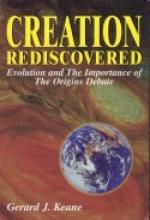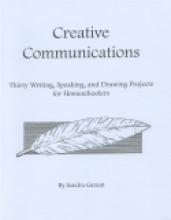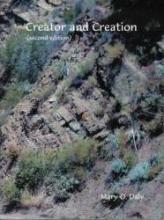No name
Counting Your Way Through ...
- Count Your Way Through Japan
- Count Your Way Through Mexico, etc.
Creating a Cooperative Learning Center
Creation Rediscovered
This substantial book covering a wide range of topics relating to the great origins debate attempts to synthesize modern, largely Protestant, scientific arguments and evidence for a literal interpretation of the biblical creation story with Catholic teaching. Mr. Keane, a Catholic layman, has obviously studied these issues for many years and believes that such a stance regarding Origins questions - including a young earth (of about six thousand years), a direct creation taking place in six days and a rejection of all forms of evolutionary theory - is essential for the survival of the Catholic faith.
For my part, I found this book rather frustrating for a number of reasons. First, although there is a great deal in the book which is true and good and that I would readily agree with, this is, for the most part, rather obvious stuff for a faithful Catholic. Beyond this, there is a great deal of speculation, assumptions and logical fallacies amidst assertions that are, generally speaking, treated as essential to Catholic belief. To make things more complex, the author writes with a very persuasive tone - appealing to good people's faith and frustration with evil to accept his opinions. The problem is that many of his first principles are true, such as that God is omnipotent (e.g. "There should be no difficulty involved for Christians to believe that God could do this, because He is omnipotent and could have suspended the creatures' normal behavior patterns." pg. 67), but they do not necessarily point to the specific conclusions that Keane wants them to.
In my email discussions with the author I have been very up front about my frustrations with his book as well as my lack of knowledge regarding many of it's scientific details. I'm not capable of sorting out all the ups and downs of this book nor of writing with great clarity about many of the issues (particularly the scientific ones). I think my greatest weakness is not being very familiar with the different possible theories regarding Origins that fall within legitimate Church teaching. Nevertheless, I can say with great certainty that the teachings of the Catholic Church are very logical and that the Church highly respects the relationship between faith and reason. Because of the poor scholarship of this book, which includes many logical fallacies and speculative arguments, I am very skeptical of its value as a source of Catholic teaching, no matter how many of its conclusions are true. I'm always one for a lively discussion about these issues and I don't necessarily have a problem with creationist theories being presented in a humble fashion and under the guidance of the Church. Unfortunately, in addition to the weak scholarship, Mr. Keane writes with an authoritative tone which may confuse readers about true Church teaching.
A brief overview of my main problems with the book:
- The author declares essential to our faith a number of points not recognized by the Church as essential (e.g. a literal 6-day creation week)
- The author appeals to our trust in God or belief in Jesus Christ to lend credibility to his arguments as if his is the only "godly" position. e.g. Keane reminds us over and over that God is incapable of error and that God was the only witness to creation, etc., which is all true, but that doesn't necessarily mean that Keane's interpretation of Genesis is correct.
- The author uses questionable Protestant soures such as the Institute for Creation Research as major scientific sources for his arguments. They're not bad simply because they're Protestant, but in the case of ICR, I believe that their flawed theology has led to flawed science. I believe there is no contradiction between Catholic teaching and the scientific method. In contrast, I believe that some of ICR's fundamental principles are incompatible with the scientific method. "All things in the universe were created and made by God in the six literal days of the creation week described in Genesis 1:1-2:3, and confirmed in Exodus 20:8-11. The creation record is factual, historical, and perspicuous; thus all theories of origins or development which involve evolution in any form are false." (ICR Tenet 3)
- The author cites Church documents and Biblical quotes that do not self-evidently support his assertions.
- He continually misrepresents other possible Catholic theories by implying (numerous times) that Catholics who believe in some form of evolution are on par with Teilhard de Chardin or other dissident theologians and that the alternative to a literal interpretation of Genesis is a mythological one. It is both illogical and unfair to define or explain something according to its most extreme example. For example, I'm sure that Mr. Keane would agree that it is unfair to characterize all pro-lifers in terms of people who shoot abortion doctors.
- By his own admission, he disagrees with a distinguished list of great Catholics in various particulars of his theory, including: Pope John Paul II (pg. 202-206) , Father John Hardon (pg. 244), Pope Pius XII (pg. 199-200), St. Thomas Aquinas (pg. 257-258) and St. Augustine (Ibid) . Please click here to read the specific quotes about each disagreement. I certainly agree that all of these authorities are capable of error, however Mr. Keane has failed to give me reason to trust his arguments and opinions over these others. Overall, my impression is that Mr. Keane appeals to authorities (particularly Catholic ones) when they support his position, and reminds his readers that authorities can err when they don't support his position.
Here is a collection of quotes from the book to give a sense of the style and content:
(pg. 242) "In the opinion of this writer, because of many conceptual problems, there is no credible third position between a young Universe without Evolution and an extremely old Universe with Evolution. When fully considered, the opposing set of beliefs could hardly be more different and do not really allow for another position."I personally am still trying to sort out the cacophony of opinions being offered in the Creation/Evolution debate. I get exasperated both by public television programs that bend over backwards to avoid discussing any concept of intelligent design and Protestant science texts that ram it down your throat in every paragraph. Amongst all this chaos I rejoice in the great writings of the Catholic Church, such as Humani Generis, that define - with great clarity and simplicity - what is known to be true (and why) and what is still open to discussion and further understanding. Unfortunately, when I read Keane's work, I have more of the sense of someone, however unintentionally, manipulating these great works to fit his own particular ideas.(pg. 109) "This concept of punctuated equilibrium was proposed by Stephen Jay Gould and Niles Eldredge and represents, at least in some of its more extreme manifestations, a partial return to the 'hopeful monster' idea."
(pg. 257) "Christ, the omniscient Creator/Redeemer who cannot deceive, knew that Scriptural passages would be grossly distorted and disbelieved many centuries later in an era plagued with doubts about Christian doctrine. As well as asserting that fidelity in marriage is most important, He may have included the reference to Creation to confirm to 20th century Christians that human beings were indeed created very soon after the creation of the Universe. Jesus would have known that all this was true and would simply be speaking in the context of actual history."
(pg. 235) "As to the scientific truth of the geocentrism/heliocentrism issue, it may be too soon to know if all the astronomical data is available and if all scientific aspects are fully understood. Some researchers argue that a valid scientific case can still be made for geocentrism, and various experiments have been conducted with respect to solar eclipses. Unfortunately, direct observation from outer space is impossible; to observe the solar system fully, in order to judge relative motion, would require traveling an impossibly long distance away from the Earth."
(pg. 264) "Even though human beings may never grasp fully the exact details of the Creation events this side of eternity, are we to be guided only by modern human experts who were not there at Creation, or rather, by what the divine Creator/principal Author of Scripture wished to reveal in Genesis via the human sacred writer(s)?"
New Oxford Review, a very conservative Catholic publication has published several critiques of Mr. Keane's book. In September 2000, NOR published a 2 1/2 pg. review of Creation Rediscovered. A few quotations from the review give its overall sense...
"The 'information age' barrages us with more data than any person could posibly absorb or synthesize. The sort of universal knowledge which was sought by the philosophers of the classical age and reached its medieval height in St. Thomas's Summa is no longer seen as achievable by today's educators. Instead we find ourselves in an era of unlimited expertise. Most people receive not so much an education in the classical or medieval sense as training in some specific field.The dominant figure in today's learning is thus neither the philosopher nor the Renaissance man, but the techno-serf. Like his feudal counterpart, he is highly skilled in his own area of experience, but is not accustomed to thinking about matters outside his limited domain. When the techno-serf turns his gaze to concerns outside his common experience, he finds himself without an appropriate intellectual framework with which to analyze and systematize what he sees.
In the introduction to Creation Rediscovered, Gerard Keane proclaims himself to be neither a theologian nor a scientist but rather a peculiar synthesis of the two which he terms an 'Origins Researcher.' Given such ambitiousness, it is clear from the beginning that his book will be either the product of an unusually broad and well-educated mind or a desperate floundering between two disciplines, neither of which is well understood. (Brendan Hodge, "'Scientific' Literalism", New Oxford Review, September 2000, pgs. 44-45)
The review concludes, "it is incumbent upon those Catholics like Keane - who would rather retain a strictly literalist interpretation of creation - not to embarrass the Church by claiming the Church is committed to a teaching to which she is not. The dangers involved were pointed out by St. Augustine in the fourth century, and can be seen in the Galileo fiasco of the 17th century, which still has repercussions today. Rather, let us follow the lead of John Paul and "fear not" - even in a world that is increasingly difficult to completely understand."
The April 2003 edition of New Oxford Review includes an article by Dermott J. Mullan titled "Fundamentalists Inside the Catholic Church: A Growing Phenomenon". This article criticizes creationists in general, and Mr. Keane in particular for their insistence on a "Young Earth" understanding of creation.
Why do I find the young-Earth development troubling? Because it flies in the face of reason.In my profession as an astronomer, I am familiar with abundant evidence from the physical world indicating that the Earth and the Sun and the Universe have ages that are measured in
billions of years.The evidence for these ages comes from at least five distinct and independent areas of research in astrophysics: expansion of the universe, stellar structure, isotope dating, white dwarf cooling, and properties of the cosmic microwave radiation. The concordance of these five methods impressive because they rely on completely distinct types of observations, and different laws of physics, to arrive at their conclusions.
It is beyond the bounds of reason to suppose that, if the Universe were actually no older than a few thousand years (as the young-Earth proponents claim), many hundreds of researchers from diverse countries and all religious backgrounds would discover five completely different methods which all yield multi-billion-year ages. (Dermott J. Mullan, "Fundamentalists Inside the Catholic Church: A Growing Phenomenon", New Oxford Review, April 2003, pg. 32)
Now it is certainly true that New Oxford Review and their authors are capable of error, as am I. However, with all of Mr. Keane's throwing around of authorities who agree with him (and it should be noted that St. Thomas Aquinas describes argument from authority as the weakest form of argument), it's comforting to know that I'm not the only one who had problems with this book.
Sample quotes from Creation Rediscovered regarding disagreements with other Catholics:
a. Pope John Paul II (pg. 202-206) "Has Pope John Paul II been inaccurately informed by his advisers, to the deteriment of truth? Some of his other scientific comments made on October 22, 1996, seem most inconsistent with the actual findings of modern science..."
b. Father John Hardon (pg. 244) Mr. Keane includes this quote from Fr. Hardon on page 244 "The origin of planets, including the Earth, also has a variety of hypothetical explanations, but with one factor in common: The planets are derivatives from the stars. It is fairly agreed that the Earth and other planets are about four and a half billion years old."
c. Pope Pius XII (pg. 199-200) "In view of truth known from Tradition and highlighted by Cardinal Ruffini, why did Pope Pius XII even allow any discussion about the possible evolution of Adam's body, as though human Evolution could somehow be true? What need was there for further discussion - surely, enough was known already from Tradition? One can only speculate."
d. St. Thomas Aquinas (pg. 257-258) "With all due respect to the great Aquinas, his reason for not accepting the literal view, which he admits is more generally held in Tradition, seems quite astonishing."
e. St. Augustine (pg 257-258) "Despite this precedent within Tradition, the enchanting appeal of uniformitarian/evolutionary concepts made a profound impact upon many Church scholars in the last two centuries, with the result that the literal-as-given, obvious sense came to be considered virtually unbelievable. Perhaps some scholars were also influenced by the views of St. Thomas Aquinas, who preferred the theory of St. Augustine."
Previously reviewed on 3-20-03, 6-6-03, 6-23-03
Donated for review by TAN Books and Publishers
Creative Communications
This is a book of projects to encourage communication - and especially writing - in practical (and often fun) ways that are especially appropriate for homeschool families. The book is divided into three sections...
The first section "Pre-Writing Projects" includes seven projects to encourage those just beginning-to-write-a-little to be well-prepared for writing by playing word and memory games, writing name tags, learning manners relating to meeting and talking to people, labeling household items, telling stories, singing songs, writing lists, etc. Far from being a list of projects, this twenty-five page section includes quite a bit of detail, adequate descriptions and many ideas for implementation of these projects. You'll also find examples of particular people working on their communication skills and ideas for gaining the cooperation of reluctant writers. I found these descriptions quite creative and it is obvious that the author has really used these ideas in her own family.
Section Two covers ten "Short Projects for Ready Writers" which includes projects such as composing prayers, having a pen pal or a "cyber-pal" to write to, writing menus, making greeting cards, taking telephone messages (and other aspects of telephone communication and etiquette), special story-writing ideas and a family newsletter project. One of the appendices also includes a listing of websites where children can find Catholic pen pals on the Internet. This section also includes tips for parents on "When Is Your Child Ready to Write?", "Communication is Worth the Work" and "Ready for Informal Grammar". I think the ideas are very practical and very homeschool-mom friendly.
Thirteen "Advanced Projects for Real Writers" are covered in Section Three. These include projects of a more advanced nature which "require spelling and grammar skills, but ... also require planning, thought, and some technical skills." These are designed for those old enough to do a good deal of independent work with parental approval but minimum parental supervision/assistance. Projects range from learning to express spiritual beliefs and convictions to writing tests and study guides, from practicing proofreading skills to simple computer programming and audio/video productions. (To give you a better sense of this section, the following is a list of the project titles: "Wearable Words", "Study Guides", "Writing Your Own Tests", "Journals with a Theme", "Magazine and Newsletter Submissions", "Proofreading Skills", "Instructional Aids", "Memory Book", "Family History", "Calendars", "Action Letters", "Computer Programs" and "Radio and Video Production".)
In addition, you'll find: extensive tips and explanations on the whys and hows of teaching writing - including helping children to be motivated to write and a short essay encouraging teens to use communication skills to do good within the community and gain valuable experience. Appendices include twenty four "plot situations" to get started on writing assignments, a listing of "How to" Books and Websites relating to the projects; suggested supplies, an overview of copyright laws and Fair Use Policies, simple grammar rules and sixteen pages of writing samples from the author's children (which help to illustrate some of the project ideas given in the text.
Most of the content is very practical (and family-oriented) in nature. Religious content extends to ideas and examples (within the various projects) that would be of interest to Catholic homeschoolers, such as writing letters to television stations to encourage moral programming and helping spread devotion to the Sacred Heart. I find the author quite creative in using ordinary experiences as good learning opportunities. I'm looking forward to digging into some of the projects with my own children this fall.
The author is a Catholic mother of three, a free-lance writer, and has been homeschooling her children since 1989.
Creator and Creation (third edition)
Nihil Obstat, Imprimatur
Crusader King, A Novel of Baldwin IV and the Crusades
Cuisenaire Rods
Cursive Connections: A Traditional Style
The text is strictly black and white with no distracting illustrations. (These details are a matter of personal preference - I prefer this simpler style and others would rather have more colorful texts.) This text would be easy to use in a homeschooling situation because of the introductory information is rather complete: "the purpose of these materials", "who uses these materials", "practice methods", "expectations of the child", "correct paper position", etc. Different sorts of cursive strokes are explained as well as several examples of poorly done letters alongside "better" and "best" examples.
Individual cursive letters are given quite a bit of practice space on their own, and then practiced alongside other individual letters (particularly those which are more difficult to connect). As more and more letters are introduced, the practice begins to include short words and some phrases. After all of the lower-case cursive letters are introduced, the text moves along to Upper Case. "When should a capital letter connect to the next letter?" and when it should be left alone is also clearly explained.
This is in no way a "religious" text. However, the words God, and many Christian names (such as Xavier) are included in the word practice pages. Also, there is absolutely no offensive or "politically correct" content.
D'aulaire's Book of Greek Myths
You can purchase this paperback or hardcover book from most homeschool companies or better bookstores. Perhaps your local library would have a copy on it's shelves that you could borrow? It can be used for a variety of ages. Younger children would like it as a 'read aloud' and older students would enjoy it as an excellent introduction to greek mythology. All in all, it is a classic retelling of Greek myths and legends, and belongs on every homeschool bookshelf.









